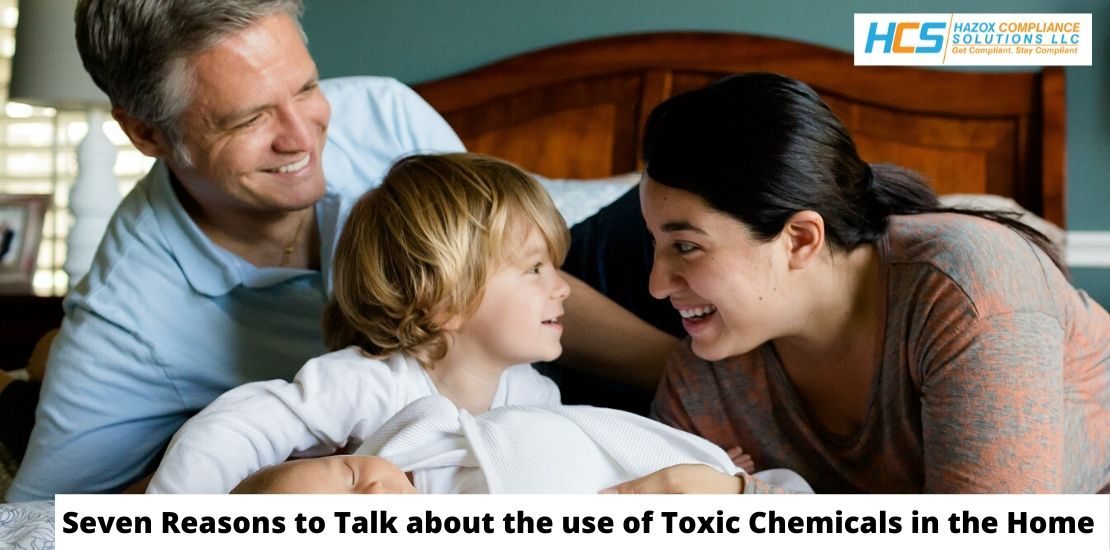- November 5, 2019
- Posted by: admin
- Category: Blogs, News

The urban lifestyle that is so much appreciated today is affected by the increasing use of chemicals in our daily lives. The toothpaste we use each day, the hair gel and other hair products, perfumes and aftershaves, medicines or nutritional supplements, paints and varnishes, even household cleaners are just examples of the many chemicals used that make our clean, fresh and hygienic lifestyle possible.
But the use of these chemicals has a price, beyond the commercial cost of the product. There are health risks that these substances or mixtures could cause to people, properties and the environment.
The first reason to talk about toxic substances in the home is that they are part of everyday life, and they involve varying consequences. For 2016 & 2017 in the USA, the number of requests for specialized assistance for possible household poisonings was 2.7 and 2.12 million people respectively (1, 2), which is equivalent to 6.4 subjects per 1000 inhabitants resulting in a call to a poison control center every 14.9 seconds.
The frequency of this type of event is the second reason that should push us to talk about these dangers at home, especially when we consider that their handling created a cost of USD$ 1,800,000,000. Poisonings affect all age groups, especially children under 6 years of age and young adults, which is why the related cost and the population affected constitute reasons three and four of this list.
When the poison information submitted is reviewed, the data shows that more than 70% of the events correspond to unintentional exposures, that is in situations that happened inadvertently to a person where they did not know the risk or did not think about the impact of the risk. This is another reason to talk about the risks of using chemical products with family members that can happen to anyone in contact with the product to prevent poisonings with potentially serious consequences.
In younger people, cosmetics and personal hygiene products are the most frequent cause of possible poisonings, followed by cleaning substances, analgesics, foreign bodies (the components of toys and other objects), topical preparations, antihistamines, vitamins, pesticides, dietary/herbal/ homeopathic supplements, and plants. Generally, in adults, medicines are the most common culprit; analgesics, sedatives/hypnotics/ antipsychotics, antidepressants, cardiovascular action medications, household cleaning substances, alcohol, anticonvulsants, pesticides, stimulants/street drugs, and antihistamines (1).
In other words, the expected industrial chemical products are not the cause of the events described in the aforementioned statistics. These are substances or mixtures in daily use, in some cases readily available and in other cases prescribed by doctors.
There is another reason to consider these discussions. Neglect, ignorance, misuse, unable to understand the requirements of the prescription or confusion, are reasons described by the majority of those affected. All of them are likely to be avoided or minimized by simply promoting education in the prevention of accidents at home.
Chemicals are present in all areas of the home, from the garage to the garden, through the living room to the bedroom, in the laundry and bathroom, as well as in the kitchen (3). Some risks include irritation and rashes, corrosive substances cause burns, some can cause suffocation, and others can cause skin sensitization or health risks from inhalation. Some of these chemicals can also cause health hazards including carcinogenic and mutagenic effects. These are just a sample of the long list of effects of substances/mixtures in use in our homes.
According to the data provided by the Cleveland Clinic, our garages contain products such as the following:
(a) Ethylene glycol which is the main component of antifreeze and that can be fatal for both people and pets.
(b) Heavy metals are frequent contaminants of the motor oil used for the proper functioning of the engine. These metals can cause health effects such as neurological damage to cancer.
(c) Water-soluble latex paints, regardless of their low toxicity, can release formaldehyde during the drying process. This causes headache, dizziness, eye or airway irritation.
(d) Oil-based paints, whose organic solvent content is a frequent cause of eye irritation and skin injury, on repeated exposure can lead to serious health problems (renal, hepatic or blood).
(e) Vehicle batteries are also dangerous products because of their sulfuric acid content (those that contain it) or due to the associated risks from the emission of explosive gases under certain conditions
(f) Windshield washer fluid is also a dangerous product due to the combination of ethylene glycol, methanol and isopropanol that can cause irritation, serious health risks, even death if swallowed (3).
Hazardous materials can also be found in the bedroom:
(g) Mothballs are a frequent risk as they contain naphthalene and p-dichlorobenzene. These emit fumes that act as irritants of the skin or respiratory tract, as well as throat, and can cause dizziness. Repeated exposure to the product can cause cataracts and liver damage.
In the bathroom, commonly used products are:
(h) Toilet cleaners contain sodium hypochlorite (bleach) and hydrochloric acid that alone act as potential irritants of airways, eyes and can even cause burns
(i) Mold and fungus removers are also commonly found. These contain chlorine and alkyl ammonium chlorides that can cause irritation and, if ingested, burns to the digestive tract. (j) Drain cleaner has a high content of bleach and sulfuric acid as ingredients. Bleach can cause irritation of the airways, skin burns, and if swallowed causes burns to the upper digestive tract. Sulfuric acid can act as an irritant and even cause severe burns, and both substances release dangerous gases (3).
The list continues with chemicals such as benzaldehyde, camphor, ethyl acetate, benzyl acetate, linalool, acetone, and methylene chloride which are all present in perfumes and whose effects range from dizziness, nausea, dryness, headache to kidney damage. We can also include bromodiphenyl ethers (PBDEs) that are often found in mattresses, and associated with neurological damage, reproductive toxicity, decreased sperm quality and thyroid problems. Phthalates (components of plastic containers) can cause endocrine disruption in humans with an impact on neurological and reproductive development (4).
Bisphenol A (present in water bottles), aluminum (antiperspirant), quaternary ammonium salts (present in fabric softeners), polytetrafluoroethylene or Teflon (which covers many of cooking pots), bromine and chlorine (used as fire retardants in children’s products), are just some of the many chemicals present in our daily life.
The presence of these chemicals push us to learn how to use these products safely to prevent the risk of poisoning and risk of severe health effects. Doing so involves consciously buying the product, knowing the hazardous chemicals in its composition, making use of natural or synthetic alternatives that are less harmful or harmless. But above all, we must learn to keep these products out of reach of children and pets, as well as using the product in accordance with the suggested recommendations and taking the appropriate precautions.
Finally, if you want to know more about these and other dangerous substances you can consult not only our website, www.hazox.com, but also that of the AAPCC, or the EPA where specialists offer information on suggested uses, appropriate modes of use and what to do in case of possible poisonings.
References:
(1) National Capital Poison Center. (2017). Poison Statistics National Data 2017 in Poison Control. Recovered from https://www.poison.org/poison-statistics-national. Date of consultation: October 13, 2019.
(2) American Association of Poison Control Centers. National Poison Data System. In the AAPCC web page. Recovered from https://www.aapcc.org/. Date of consultation: October 14, 2019.
(3) Cleveland Clinic. (2019). Household Chemical Products and Their Health Risk at Cleveland Clinic. Recovered from https://my.clevelandclinic.org/health/articles/11397-household-chemical-products-and-their-health-risk. Date of consultation: October 14, 2019.
(4) Ndes S. (s.f.). 20 Toxic Things You Probably Use Every Day in Lifehack. Recovered from https://www.lifehack.org/articles/lifestyle/20-toxic-things-you-probably-use-every-day.html. Date of consultation: October 14, 2019.
